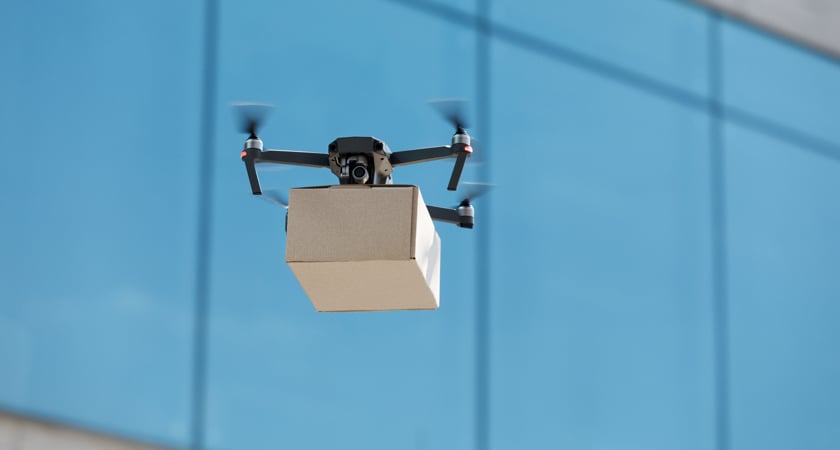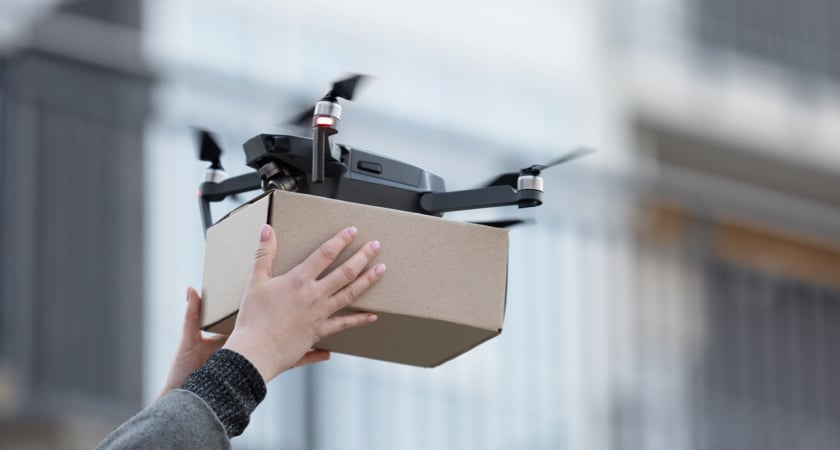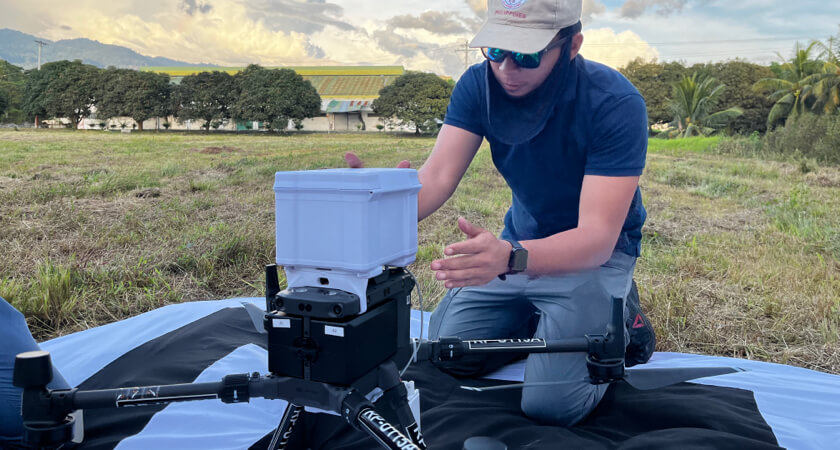Delivery drones could very well be The Next Big Thing for businesses to deliver goods to their customers. They can also be extremely helpful in transporting sensitive items such as medical supplies to areas that need them. Lately, many autonomous drone companies such as Amazon Air, Flirtey, and Google Wing have been experimenting with drone delivery, all in the hopes of one day making it mainstream.
Evolving drone use laws and drone delivery
The federal government has established laws pertaining to drone use in the U.S. Specifically, the Federal Aviation Administration has created regulations pertaining to autonomous drones. These include stipulations such as:
- Don’t operate your drone carelessly or recklessly.
- Stay away from manned aircraft.
- Don’t pilot a drone from a moving vehicle unless certain conditions are met.
- Don’t fly over people, except under specific circumstances.
- Don’t operate more than one drone at a time.
- Keep your drone within your line of sight.
- Fly during daylight hours; twilight hours are OK if the drone is equipped with anti-collision lighting.
- Keep the drone within 400 feet of the ground or near a structure.
- Don’t exceed 100 mph.
In addition, remember to register your drone.

The benefits of drone delivery
Drone deliveries come with various pros, namely:
- Enhanced logistics. Deliveries performed by traditional vehicles such as vans need to stick to the roads, which can prove challenging when carriers are planning routes to get from a warehouse to a customer. Drone deliveries are completed in a straight line from the sorting center to the package’s destination, making the logistics of the operation far more efficient.
- Underdeveloped areas are better served. In many areas around the world, traffic issues combined with underdeveloped roads mean deliveries take a long time to complete. Delivery drones don’t have to deal with road traffic at all, meaning companies that make deliveries can expand much more easily into these areas.
- Speed. Drone deliveries are essentially a direct-to-customer airmail solution, making them much faster than traditional delivery methods.
- Less traffic. According to Amazon, the vast majority of customer packages are less than five pounds, making them ideal for drone technology. As it stands now, all of those packages are taking up space in delivery vehicles. If drone deliveries could take over all of those light packages, it would free up room in the delivery vehicles, meaning fewer would need to be on the road at one time.
- Cost. Labor costs are rising across the U.S., meaning traditional deliveries will only get more expensive over time, according to Zippia. While the initial price of drone technology may be high, there is far less labor involved, making drone deliveries more cost-effective over time.
- Environmentally friendly. Most drones run on electricity, making them exceptionally green. Also, with fewer delivery vehicles on the road, carbon emissions would drop.

BVLOS piloting
BVLOS piloting — Beyond Visual Line of Sight piloting — means controlling a drone that’s far enough away that you can no longer see it. Currently, such maneuvers are considered illegal because if you can’t see your drone, then your awareness of what’s around it becomes substantially limited. The risks of the drone crashing or being lost heighten dramatically under BVLOS conditions. This is a particular challenge for delivery drones that are automated and not piloted by a human operator.
Current use cases for drone delivery
Dronegenuity lists a wide range of applications where drone delivery is being used:
- Food delivery. The first pizza delivery via drone occurred in 2016 in New Zealand. That same year, 7-Eleven teamed up with drone company Flirtey to complete 77 deliveries in Reno, NV. Uber Eats, as part of its Uber Elevate initiative, expects to be commonly using delivery drones as early as 2023.
- Health care. Whether it’s to transport medical supplies or organs, drone delivery has a promising future as a means of distributing items to difficult-to-reach areas. In May 2019, a kidney for transplant was flown via drone to a patient in Baltimore. Drones can also be used to deliver vaccines in a cold centralized container or transport prescriptions to nursing homes, a practice being pioneered by WeRobotics and Flying Labs.
- First response. Surveying areas after natural disasters or utilizing “ambulance drones” equipped with lifesaving equipment such as defibrillators are potential emergency response applications of delivery drones.
- Humanitarian aid and disaster relief. In 2017, after Hurricane Harvey hit, drones repaired power lines in Houston, TX. In 2018, after a massive fire spread across Hechingen, Germany, drones were used to take images so fire teams would know where to deliver water.
- Retail. According to Harvard, UPS is exploring a hybrid solution in which a delivery truck would carry packages to a neighborhood and then use drones launched from the delivery vehicle to deliver all the packages in that neighborhood. This is sometimes referred to as “last mile” drone delivery.
How much faster is drone delivery compared to traditional delivery methods?
The amount of time a drone delivery takes is determined by how fast it can travel from point A to point B in a straight line. The “in a straight line” part is key, as that’s a large part of what makes drones so valuable for companies that need to transport goods quickly and efficiently.
As previously mentioned, drones can avoid the usual twists, turns, and traffic of roads, which makes them highly suitable as an alternative to traditional delivery methods. While the actual speed for delivery can vary depending on the amount of distance traveled, drones are typically capable of moving up to 50 mph.

Amazon Prime Air
Amazon has been experimenting with drone delivery for many years as part of Prime Air. The company first announced its intention to make Amazon drone delivery a mainstream service in 2013 as part of a 60 Minutes segment.
Since then, the company has encountered numerous difficulties and setbacks that have kept it from its highly ambitious goal of making Amazon Prime Air mainstream “within four to five years,” as Jeff Bezos stated in the interview. However, in August 2020 Amazon earned the FAA’s permission to conduct drone operations and has since logged thousands of hours of flight time, meaning the project is still alive and progressing.
Next steps for future drone delivery
Mainstream drone delivery is likely not too far off. Aside from Amazon Air, other companies have been getting in on the action as well, and might even outpace Amazon. Flirtey was the first drone company to fly an FAA-approved delivery drone in 2015 and as of 2021 is taking pre-orders for its line of drone products, according to Modern Shipper. Notably, this includes their F4.5 model, which is also known as the Eagle. Flirtey is a fast-growing company poised to contribute heavily to the delivery drone industry: As of 2021, the business was valued at approximately $100 million.
According to PC Mag, another drone delivery company, Zipline, has already started making prescription airdrops in Utah as of October 2022 in coordination with Intermountain Healthcare. Previously, in 2016, Zipline got its start in Rwanda transporting medical supplies such as vaccines. In 2020, the company signed a deal with Walmart to deliver health and wellness products via drone.
In 2021, Google’s Wing drone delivery service utilized unused space atop shopping malls in Queensland, Australia to build drone centers, according to Forbes. These hubs can transport goods straight from retailers in the mall to customers’ homes. Because flights last a mere few minutes, consumers can purchase a food item such as ice cream and the product will still be frozen when the delivery arrives. Queensland is one of three test centers for Wing, with the others operating in Helsinki, Finland, and Christiansburg, VA.
Any or all of these companies could lead the way into the future of drone delivery, but one thing appears certain: Drone delivery will be here soon as soon as all the complexities are worked out.
Get the right drone loadout for drone delivery
A drone’s cargo generally has to be fairly lightweight. Amazon Air requires packages to be less than 5 lbs, for example. Assuming the retailer's drones all have similar carrying capacities, this makes them ideal for delivering most of Amazon’s catalog, including medical supplies, food and drink, and other relatively light products.
WeRobotics has already successfully developed a delivery solution with the Matrice 300 RTK. M300 Cargo leverages a widely available commercial drone and can deliver packages up to 7km away.

A delivery drone’s battery typically lasts for about 40-45 minutes before needing to be recharged, so customers have to be relatively close by for delivery drones to be able to service them. The aforementioned hybrid solutions combining traditional delivery vehicles with delivery drones such as those from UPS hope to mitigate this limitation.
Drone delivery is set to be the future of goods transportation
There are numerous benefits to autonomous delivery drones that make them ideal for the transportation of goods. Progress has been slow but steady, which is to be expected for such a complex and technologically advanced product that also requires oversight by FAA regulations just to be safely tested. At the current rate, though, delivery drones are set to make their impact soon through small airdrops due to their cost-efficiency, speed, and genuine practicality.
If you’d like to request a demo of our products, inquire about price or ask us anything else, contact us at DJI today to get started.



.png?width=300&name=FH2%20update%20(1).png)
-1.png?width=300&name=HS%20-%20Featured%20Images%20(3)-1.png)
